

Mr. Wilbur Wright, of Dayton, Ohio, recently read a most interesting paper before the Western Society of Engineers, entitled "Some Aeronautical Experiments," and this paper was afterward published in the Journal of the Society. Through the courtesy of the Society we are enabled to present a series of engravings illustrating the article. Mr. Wright's attention was drawn to the study of aeronautical problems a number of years ago, and his active interest dates back to the death of Lilienthal in 1896. The experiments of Pilcher and Chanute also stimulated Mr. Wilbur Wright and Mr. Orville Wright to try some experiments in 1900, which were conducted on the seashore of North Carolina. These gentlemen have been bold enough to attempt some things which neither Lilienthal, Pilcher nor Chanute dared to do. They have used surfaces very much greater in extent than those which hitherto have been deemed safe, and have accomplished very remarkable results. It was the plan of Messrs. Wright to glide from the tops of sandhills. It seemed reasonable that if the body of the operator could be placed in a horizontal position, instead of the upright, as in the machines of Lilienthal, Pilcher and Chanute, the wind resistance could be very materially reduced, since only one square foot, instead of five, would be exposed. As a full half-horse power could be saved by this change, they arranged to try the horizontal position. The first machine had an area of only 165 square feet. It was first tested as a kite, and valuable data as to the angles were obtained. They then turned their attention to making a series of actual measurements of the lift and drift of the machine under various loads The results obtained were most astonishing, for it appeared that the total horizontal pull of the machine, while sustaining a weight of 52 pounds, was only 8 1/2 pounds, which was less than had previously been estimated for head resistance of the framing alone. On the other hand, it appeared sadly deficient in lifting power as compared with the calculated lift of the curved surface of its size.
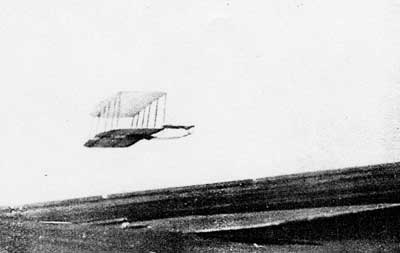
In Midair.
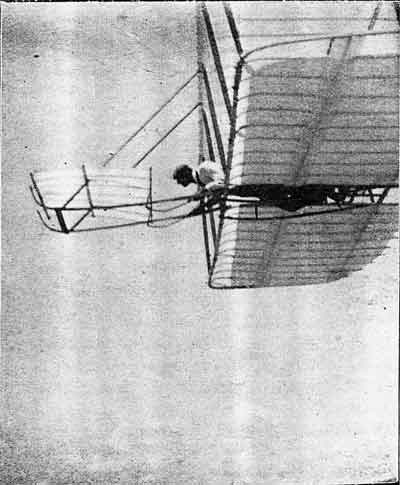
Soaring.
Their attention was next turned to gliding, and a small hill which rose from flat sand to a height of more than 100 feet was selected, the slope having an inclination of ten degrees. A dozen glides were made with the wind blowing at 14 miles an hour. The operator placed himself in a horizontal position, and two assistants started the machine. Neither machine nor operator suffered any injury The control of the apparatus proved even better than they had dared to expect, responding to the slightest motion of the rudder With these glides the experiments for the year 1900 closed. The new machine for 1901 was exactly like the previous machine in theory and method of operation, but its lifting power was increased from 165 square feet to 308 square feet, although so large a machine had never before been deemed controllable. A special building was erected to house the apparatus. Quite a party went south to view the experiments, which were begun with the wind blowing 13 miles an hour. Various glides were made in order to find the center of gravity of the operator. The machine sailed off and made an undulating flight of a little more than 300 feet. To the onlookers this flight seemed very successful, but to the operator it was known that the full power of the rudder had been required to keep the machine from either running into the ground or rising so high as to lose all headway. The experiments also showed that one of the greatest dangers in machines with horizontal tails had been overcome by the use of a front rudder, and the operators escaped from positions which had proved very dangerous to preceding experimenters. In subsequent experiments the machine with its new curvature, never failed to respond promptly to even small movements of the rudder. Many glides were made whenever the conditions were favorable.
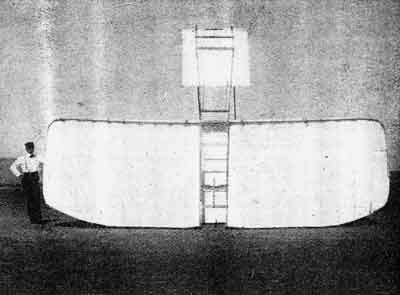
A Bottom View.
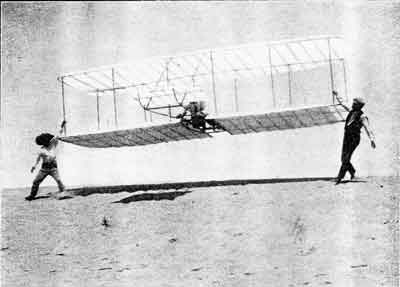
Beginning of a Flight.
A most interesting series of photographs were taken, some of which we reproduce. Our readers are referred to Mr. Wright's original paper for an elaborate technical description of the principles involved in the experiments.
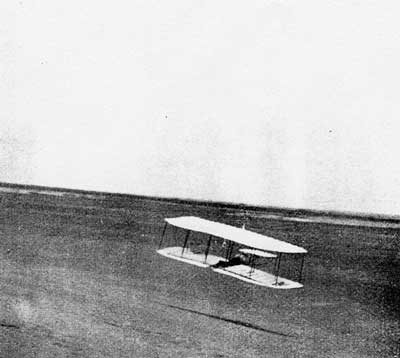
A Low Glide.
Originally appeared in Scientific American, 86, February 22, 1902, p. 125.
sbck/htgb